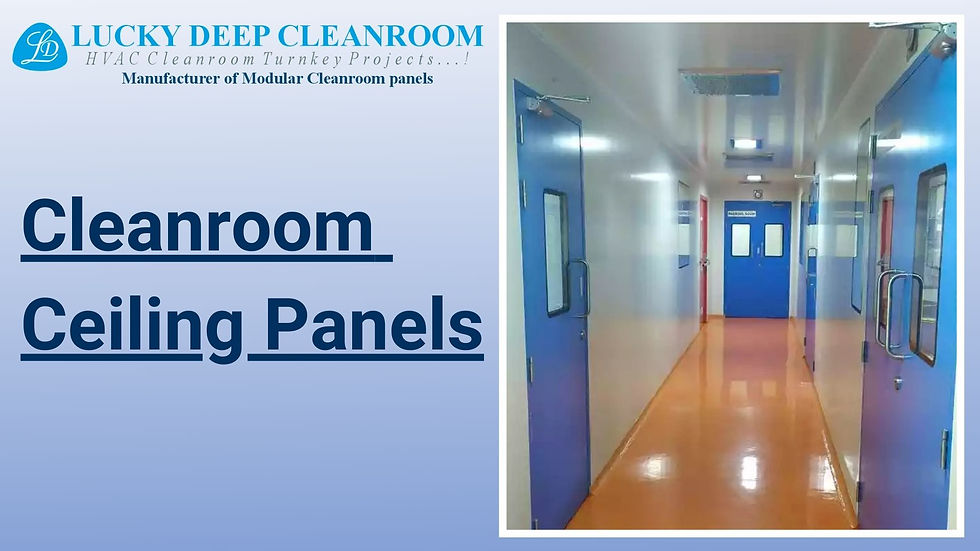The Ultimate Guide to Clean Room Doors: Features, Specifications, and Benefits
- Lucky Deep
- Feb 2
- 2 min read

Clean room doors play a crucial role in maintaining the integrity of controlled environments, ensuring proper contamination control, and enhancing operational efficiency. Whether used in pharmaceutical units, laboratories, or high-tech manufacturing facilities, these doors are designed to meet stringent industry standards. In this blog, we’ll explore the key features, construction materials, and benefits of Clean Room Doors, highlighting why they are essential for a secure and hygienic workspace.
Clean Room Doors: Construction and Material
Clean room doors are crafted using double skin panels with or without view panels, ensuring durability and optimal performance. The structure is similar to modular panels and is assembled with specialized door profiles for a seamless fit.
Material Used: GPSP GI Sheet (0.8 mm thick) for standard doors & GPSP GI Sheet (1.2 mm thick) for fire-rated doors.
Frame Thickness: 1.2 mm for standard doors & 1.6 mm for fire-rated doors.
Shutter Thickness: Available in 42 mm, 44 mm, and 46 mm for various applications.
Finishing and Coating
To enhance durability and corrosion resistance, clean room doors are available in powder-coated and stainless steel finishes. The powder coating thickness ranges between 60-80 microns, providing superior protection against environmental factors.
Available Sizes
Clean room doors come in multiple standard sizes to fit different operational requirements.
Frame Thickness Options: 50 mm, 80 mm, 100 mm, and 150 mm.
Door Width Options: 750 mm, 900 mm, 1000 mm, 1200 mm, 1500 mm, 1800 mm, 2000 mm, and 2200 mm.
Essential Door Accessories
To enhance functionality, clean room doors are equipped with high-quality accessories:
Hinges: Stainless steel hinges (3-4 per door) for durability.
Handles: Stainless steel ‘D’ type handles (20 mm dia., 300 mm long) for an easy grip.
Push Plate: 125 x 300 mm stainless steel push plate for added convenience.
Door Closure: Dorma TS-68 door closure with a standard arm mechanism.
Locking System: Key-operated locking arrangement for security.
Automatic Bottom Seal: Ensures airtight closure.
View Panel: 6 mm thick safety glass for visibility and safety.
Panic Bar: Installed for emergency exit doors.
Flush Tower Bolt: Used in double-door configurations.
Kick Plate: 300 mm high stainless steel kick plate for durability.
Interlocking System: Enables controlled access and contamination prevention.
Filler Material Options
The core of clean room doors is filled with high-quality insulation materials to enhance thermal efficiency and noise reduction:
PUF (Polyurethane Foam): 40±2 kg/m³
PIR (Polyisocyanurate): 48±2 kg/m³
ROCKWOOL: 96±2 kg/m³
Benefits of Clean Room Doors
Enhanced Contamination Control: Prevents the ingress of dust, bacteria, and other contaminants.
Fire Resistance: Fire-rated options provide additional safety in high-risk environments.
Durability: Powder coating and stainless steel construction ensure longevity.
Energy Efficiency: High-quality insulation materials help regulate temperature and reduce energy consumption.
Customizable Sizes: Available in various thicknesses and dimensions to meet industry requirements.
Conclusion
Clean room doors are a vital component of controlled environments, offering superior protection, security, and durability. With advanced features such as automatic seals, interlocking mechanisms, and high-quality finishes, these doors are designed to meet the highest industry standards. Whether you're setting up a new clean room or upgrading an existing facility, investing in high-quality clean room doors is a smart choice for long-term efficiency and compliance.




Comments